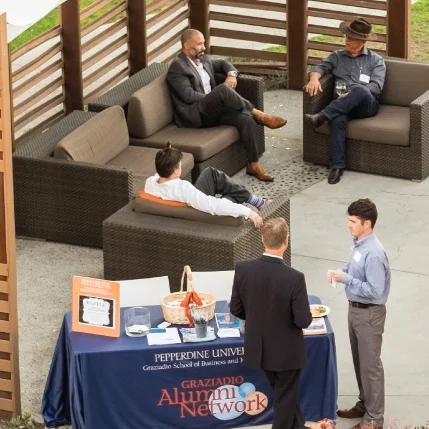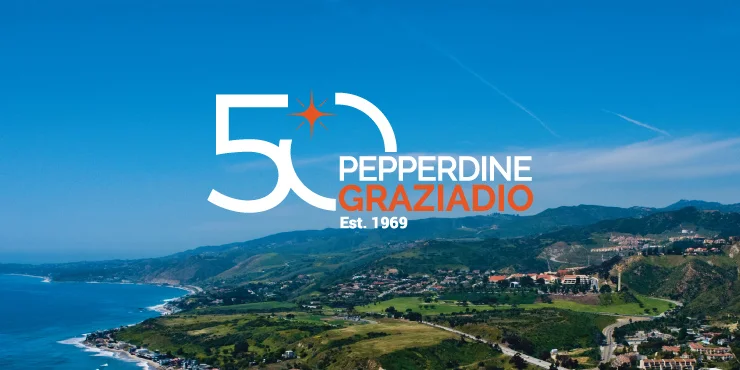Robin Doty
Silos. Silos! We all know they stand in the way of our teams being more innovative, collaborative, and effective.
But what are silos, really? They are walls that are there because we put them there. We put them there every day with our lack of openness, our protecting scarce resources, and our intense focus on our own goals without consideration of others’.
Silos aren’t structures—they are systems, systems that we create and sustain ourselves. And it takes systems to dismantle them.
Robin Doty is Senior Director of Alumni and External Engagement at Pepperdine’s Graziadio Business School. She and members of her team recently presented on this topic at the CASE D7 Conference in California. I spoke with Robin and asked her to share some insights from her presentation, “Disrupting the Alumni Engagement Ecosystem to Be More Innovative, Collaborative, and Effective.”
What problems are you trying to solve by making alumni relations more innovative, collaborative, and effective?
In alumni relations, part of our job is building relationships and connecting alumni in meaningful ways to the institution. In the field of alumni relations today, we have a lot of competition in doing that. We are competing with numerous nonprofits and outside interests that consume the time of our alumni. Alumni have choices: Where are they going to give their time, talent, and treasure? It’s important that we stand out in all that noise and provide an opportunity for them to meaningfully connect. We are consistently developing strategies for how we can be more innovative, collaborative, and effective in doing that for our institution.
What are the obstacles you’re facing, and that alumni relations as a whole is facing? Why isn’t everyone being more innovative, collaborative, and effective?
I think that in alumni relations as well as our academic areas we’ve been siloed within our departments. We do not have a lot of extra time for collaboration. People think, “Oh, alumni relations? Those are the people who make friends.” That’s it. I don’t think our stakeholders truly understand the value proposition of what alumni relations can do for the organization and how critical a role we play within the institution.
Part of improving that is breaking out of those silos. How have you built relationships to break those walls down?
There are two areas we’re focused on. One is operational: systems and processes. The other is the relational: relationships and the people side. When you’re engaging your alumni, you have to have several stakeholders involved. And when I talk about stakeholders, I’m talking about our career services office, advancement and development, student program offices, recruitment, our faculty, and our department chairs. All those stakeholders are engaging alumni whether we know it or not. So it’s essential that we work together collaboratively so that we are not only helping stakeholders engage alumni, but also helping alumni identify ways to help the institution in areas that they’re passionate about.
One of the pitfalls within our institutions is that we don’t do a good job at connecting the dots. We’ve got event planning down. We do a great job of bringing alumni into the room. But that’s only the beginning, the first touchpoint. The second touchpoint is critical. You need to find innovative ways to engage as many alumni as you can that attend the event. You can’t do that alone as an alumni relations office. That’s how we’ve been operating over the past 20+ years. We were the primary gatekeepers between alumni and the institution. We would engage alumni in event planning and chapters and regions and councils, maybe dabble in alumni mentorship or with speakers in the classroom. But what we need to do now is become more scalable by collaborating with stakeholders across the institution. We need to proactively engage alumni and create a system that identifies who wants to be connected and a process that enables that connection seamlessly. It takes a village.
When it comes to building relationships with stakeholders, what have you found to be most productive?
It’s a journey, and we’re in the middle of it. This isn’t a system that we have down pat. But I can share some things I’ve seen that has really made a transformation for us. One is the way in which we collect the information of which alumni want to be involved and how. Our secret sauce is our process when alumni register for an event. We require them to identify how they want to be involved and give them 15 different options: Do you want to help mentor students, do you want to help provide an offsite at your company, would you like to be a judge in a program, are you interested in our Women’s Center, etc.? That data collection is the first step in the system.
The second step is building a relationship. Let’s take an example, the Center for Women in Leadership. We have all of these alumni who have attended events and expressed an interest. Our newly created “alumni concierge” connects them with the faculty member leading that center. What I’ve done then is established trust and provided value to that stakeholder. It lets them know that alumni relations is here to partner with and help them succeed. Their success is our success. I’m also helping that alumna succeed in growing and forming connections with other women in business. I’m creating the win-win-win and building trust. As you build that trust, stakeholders reciprocate. Once you give them something, they become more open to providing you something in return. They’re likely to say, “By the way, we have this other alumna coming.” Then I can start tracking alumni involvement with the Center for Women in Leadership as well because I’ve built that trust, and I’ve showed them that I’m here to help them—not to take their connections away.
That reminds me of something that someone I spoke to recently said: “We’re in alumni relations, what we do is build relationships. Why don’t we do it internally at our institutions?”
Absolutely. We’re a business school within an institution. How can we be a better partner to our university stakeholders? Our alumni affairs department manages all five schools, how can we work together? It’s all about collaborative partnership. It’s amazing how much you can learn by working together because other stakeholders bring different perspectives.
I’ll give you an example. In working with our career team, we were feeding them names for mentors over and over again. After we met and we partnered with them, what we found out is they don’t need alumni to be mentors. What they needed was alumni who could provide offsite visits. It was an aha moment. If we just sat down with them last year and asked them, “How can we be a partner to you?” it would have been obvious. But because we’re so busy in alumni relations, we don’t have a lot of time to plan. If we can get the system humming, it helps us have more time to plan.
I just had a meeting this morning with my assistant director to strategize. We have an event, a technology mixer in San Francisco tomorrow. We have a registration list of a hundred and fifty people. Now, if all we know is their name and job title, how many people do you think the two of us are going to be able to build relationships with? But because of our process and our system in registration, data collection is guaranteed. They are required to answer our involvement interest question. They can tell us whether they’re interested in getting involved and how they want to get involved. Then I have a targeted list of who I need to go talk to about what at that event. We just picked 14 people who are interested in getting engaged with the school who we can go talk to and find out more about how we can help them succeed. It’s no different from what development does. Instead of “Ok, who’s here at the event, let’s look at titles, who’s coming? Let’s go talk to Joe at YouTube, he’s a senior executive.” This method helps you to identify what Joe is interested in learning more about so you can be better prepared at the event and more intentional about engaging him.
Two or three years ago, we would have an event and ask, “Recruitment, do you want to table at our event?” and they might say, “No, we have our own event.” Now we’re starting to work together and actually being targeted about getting prospective students to come to these events and intentional about having the right brochures at those events for who we’re targeting. We’re working with other stakeholders as well to leverage our events better and collaborate more for the success of the institution.
You use the verb “strategize,” but it sounds to me like the most fundamental part of what you’re doing is listening, whether it’s to stakeholders on campus or to alumni. Part of that is going out there and actively asking questions of them. Does that ring true to you?
Yes, you’re exactly right. That’s what it’s all about, asking the right questions. I find that probably 85 percent of alumni really want to get involved and engaged. They really want to help. But they don’t know how. They don’t know where to start. We have to be experts at connecting the dots. It’s what I consider finding their passion and fulfilling it, connecting their passion with the needs of the institution. You have to ask the right question the right way. And when you have 150 people in the room, there is no way you can do that from the podium. That’s a one-way exchange. That’s what we typically have done, “Blah blah blah, these are the ways you can get involved.” And they walk away with no call to action.
It’s a work in progress, it’s a journey. We’re excited about it, and I’m excited about my stakeholders and what I’m learning from them. Our systems still aren’t that great either. You asked about challenges we face, and I think we all have those challenges. Many alumni offices struggle with having disparate systems. One system is collecting online community alumni contact data. One system is your advancement system for the institution, one system is your career office system, another system is your survey system, and then there’s all the ad hoc systems. They are not all seamlessly integrated together in one system, so that’s a tremendous resource strain on our staff as they strive to collect, track, manage, and report data. But that is a whole other area to discuss another day.




